Last Updated on January 24, 2024 by Greg Gillson
That active little bird that lands on your feeder to eat upside-down is a nuthatch!
Almost any kind of bird may hang upside-down at your feeder for a little while. But the bird that is famous for its upside-down lifestyle is the nuthatch.
Actually, there is not just one nuthatch. There are several kinds of nuthatches. We’ll discuss the 4 North American nuthatches below.
We’ll discuss why nuthatches hang upside-down.
And we’ll also discuss how to attract nuthatches to your feeder.
But first…
What do nuthatches look like?
 |
| A nuthatch hangs upside-down from the porch roof. |
Nuthatches are quite small birds about the size of a chickadee–4 to 5-1/2 inches long, bill tip to tail tip.
But nuthatches are different than chickadees. Nuthatches have long pointed bills; chickadees have short stout bills. Nuthatches have very short tails; chickadees have very long tails.
The feet of nuthatches are large and strong with long claws to grip the bark of trees.
Most nuthatches around the world are blue-gray above. Many have white breasts. Others have rusty breasts and a white eyestripe.
But why do nuthatches hang upside-down to eat?
First of all, nuthatches don’t always eat upside-down. They can eat in any position. And they do!
Nuthatches don’t weigh very much. With their strong feet, they can easily hang onto tree bark (or your feeder) in any position.
Other birds might look for food on leaves and twigs. But not the nuthatches. They crawl over and around, up and down the trunk and heavier branches. They look for food on the bark.
By concentrating on the bark, the nuthatches find different foods than the birds that are feeding out on the foliage. And by traveling down the tree head-first, they may see insects and invertebrates that other “right-side up” birds miss.
They are so used to eating upside down, that they often feed upside-down even when they really don’t have to!
We’ll talk more about what foods nuthatches eat, and how to attract them, below. But first, let’s look at the different kinds of nuthatches.
Where do upside-down birds live?
Where can you find nuthatches?
Well, nuthatches live in forests and woods of many kinds. Different kinds of nuthatches are found in different kinds of trees and forests. Look below to the individual accounts of each species.
General Nuthatch Facts:
Nuthatches are found in the northern hemisphere around the world.
There are 29 recognized species of nuthatches in the world.
The highest variety of nuthatch species is found in Southeast Asia.
How to find nuthatches: Mixed Feeding Flocks:
Within the woods, you can often find nuthatches by looking for mixed feeding flocks. These are flocks composed of several species that feed together.
The core of these mixed flocks is often chickadees and titmice. They are joined by nuthatches, downy woodpeckers, brown creepers, kinglets, and often other small birds like warblers and vireos.
The advantage of a mixed feeding flock is that there is safety in numbers. More birds can look out for danger, such as a Cooper’s or Sharp-shinned hawk.
The disadvantage of mixed feeding flocks is that you have to compete for food with the whole flock! Now the upside-down eating habits of the nuthatches give them an advantage. Other birds in the mixed flock looking on the bark for food are the Downy Woodpecker and Brown Creeper. But they can only go up the tree headfirst!
Kinds of upside-down birds in North America
There are 4 species of nuthatches north of Mexico. Depending upon where you live, there may be 1 to 3 different kinds of nuthatches in your yard and at your feeder!
Well, if you live in the desert or Great Plains, you won’t have nuthatches regularly. But in some years you may have Red-breasted Nuthatches visit in winter.
White-breasted Nuthatch
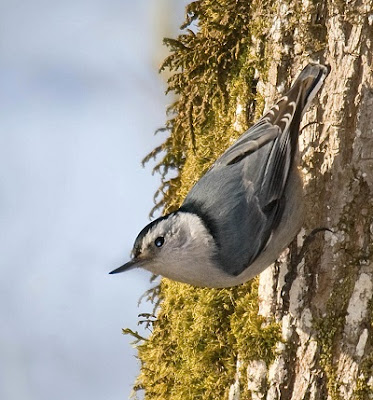 |
| White-breasted Nuthatch. Greg Gillson. |
White-breasted Nuthatches live in deciduous woods, usually with oak trees. In the West they occur in pine-oak and even ponderosa pine forests.
To find them look in oak groves. They usually occur only in pairs or small family groups.
This is the largest nuthatch in North America, only 5-3/4 inches long, bill tip to tail tip.
They eat mostly insects in summer. So, they only visit feeders in fall and winter to eat nuts and sunflower seeds.
They are year-round residents in every state in the Lower 48. But they don’t occur everywhere in each state. They are resident well into Canada, south of the boreal forests.
These upside-down birds will nest in bird houses. The dimensions are the same as those made for chickadees: 5×5-inch floor, 7 inches floor to ceiling. A hole the size of a Quarter. No perch.
Red-breasted Nuthatch
 |
| Red-breasted Nuthatch. Greg Gillson. |
Red-breasted Nuthatches are birds of conifer forests. They are resident from southern Alaska across Canada and in the northern tier of US states. They also live year-round in Appalachians in the East, and mountains of the West south into Mexico. In summer they nest farther north in Canada.
To find them look in pine trees. They often appear singly or in pairs.
Red-breasted Nuthatches move south in winter in response to food supply. In some years they stay north in their summer range. In other years they move southward. Every few years they irrupt so that large numbers move south throughout ever state in the Lower 48, visiting feeders.
These birds visit feeders in fall and winter. In fall, they may take sunflower seeds and hide them away for winter. Back-and-forth they come and go at the feeder. They also love nuts, peanut butter, and suet.
These nuthatches usually excavate their own nests.
Brown-headed Nuthatch
 |
| Brown-headed Nuthatch. mlmclaren. Pixabay |
These tiny little birds live year-round in pine forests in the Southeast–Virginia to easternmost Texas.
To find these birds, listen in pine woods. They travel in loose flocks, continuously making small contact calls. Their song is described as like a rubber duck squeak.
Offer these birds black oil sunflower seeds, nuts, and suet.
Pygmy Nuthatch
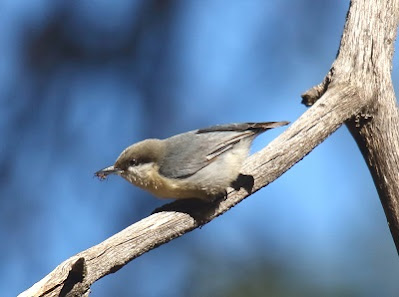 |
| Pygmy Nuthatch. Greg Gillson. |
These birds inhabit ponderosa and Jeffery pine in mountains of the West, from British Columbia well into Mexico.
To find them, search in stands of mature pines in campgrounds and ski resorts. Listen for large traveling flocks giving constant peeping calls.
Pygmy Nuthatches are even smaller than Brown-headed Nuthatches! They are only 4-1/4 inches long, bill tip to tail tip.
They eat nuts and sunflower seeds.
What do you feed upside-down birds to attract to your feeder? What do nuthatches eat?
We discussed this a little bit above. Here are more details.
Since nuthatches look for food on the bark, beetles are a major food source. They also eat caterpillars and spiders.
Thus, live mealworms are a favorite food of nuthatches.
They are called NUT-hatches, after all. And they do love nuts. In their natural habitat, White-breasted Nuthatch eats acorns from oaks as well as hazelnuts and beechnuts.
The other three nuthatches eat pine nuts in the forests where they live.
If you purchase a mixed seed variety with peanuts and tree nuts, the nuthatches will thank you!
Nuthatches love black oil sunflower seeds! They can’t chew like sparrows and finches. So, they must take the seed away to open it. They hold the seed with their feet and pound it open with their bill. You may hear woodpecker-like tapping in the woods in fall and winter, only to discover it is nuthatches!
In the fall, nuthatches store seeds away in holes and crevices in the bark. They’ll eat them later in the winter. This future food supply is called a cache. Hundreds of sunflower seeds may disappear each day in fall this way!
Nuthatches love to eat peanuts! Unsalted. Out of the shell. They don’t mind them large and unbroken.
Nuthatches love suet! Plain suet seems just as appealing to most feeder birds as the fancy ones with fruit, mealworms, or seeds.
A suet supplement or suet replacement is peanut butter. You may find products online for peanut butter suet, or products called Bark Butter and Peanut Dough.
What kind of feeders do nuthatches like?
Nuthatches aren’t too particular about their feeders. They don’t spend much time there. They just grab a nut or seed and run.
However, to keep the competition with larger birds down here are some suggestions.
Tube feeders with black oil sunflower seeds are favored by finches, chickadees and nuthatches. Larger birds can’t fit on the small perches.
Nuthatches easily pass through caged bird feeders. These have feeders inside a cage. Only smaller birds can get in to the food.
Of course, nuthatches love suet. Suet must be fed in special suet feeders.
And don’t forget the peanut feeder. These bird feeders dispense shelled peanuts.
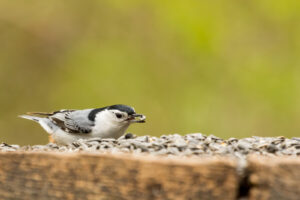
When do upside-down birds come to your feeder?
Nuthatches eat mostly invertebrates in summer. They feed these to their nestlings. So, it is not unusual for the nuthatches to “disappear” from feeders in spring and summer. They’ll be back in the fall.
Begin looking for nuthatches in your feeder in fall. At that time, they may take the seeds away and store them for winter. They cache seeds away in the bark of a tree–the rougher the bark, the better. And they don’t go far. Chickadees also cache seeds and they only go up to 130 feet from the feeder. So nuthatches are probably similar.
Nuthatches will visit daily all winter into spring.
During nesting season, nuthatches switch to an insectivorous diet. They will stop visiting the feeder in spring and feed only invertebrates to their young.
Wrapping Up
Nuthatches are not rare in the United States. In fact, they are quite common and widespread across the country. There are four species of nuthatches found in the US:
- White-breasted Nuthatch: This is the most common and widespread species, found in all but the extreme southwestern states. They are easily recognizable by their black cap, white breast, and gray back.
- Red-breasted Nuthatch: This species is found in coniferous forests across the northern United States and Canada. They are smaller than white-breasted nuthatches and have a rusty patch on their breast.
- Pygmy Nuthatch: This is the smallest species of nuthatch in North America, found in the western mountains from Alaska to Mexico. They have a gray back and a white breast with a black streak down the middle.
- Brown-headed Nuthatch: This species is found in the southeastern United States, primarily in pine forests. They have a brown head and back, and a white breast with a black streak down the middle.
The populations of all four nuthatch species in the US are considered to be stable, and they are not listed as threatened or endangered by the IUCN. In fact, white-breasted nuthatch populations are actually increasing in some areas, likely due to the availability of bird feeders.
So, if you live in the United States, you have a good chance of seeing a nuthatch in your backyard or local park. They are active year-round and can be easily attracted to feeders with suet or nuts.
Frequently Asked Questions
What is unique about the Nuthatch?
Nuthatches are fascinating birds with several unique characteristics that set them apart:
Acrobatic prowess: Unlike most songbirds, nuthatches can walk both up and down tree trunks with ease. This is thanks to their specially adapted feet, with a strong opposable toe on each foot. This unique ability allows them to access hidden insects and seeds in crevices that other birds might miss.
Seed hacking skills: Their name, “nuthatch,” comes from their habit of hacking open nuts and seeds. They wedge the nut into a crevice in the bark and use their strong bill to hammer it open, accessing the nutritious kernel inside. This clever behavior, along with their acrobatic movements, showcases their resourceful nature.
Vocal prowess: Nuthatches are known for their loud and distinctive calls, which vary depending on the species. These calls often sound like nasal whistles, chatter, or rattles, and they serve various purposes, like communication, territory defense, and attracting mates.
Nest-building ingenuity: While some nuthatch species use natural cavities, others exhibit unique nesting strategies. The brown-headed nuthatch, for example, lines abandoned woodpecker holes with mud, creating a hardened entrance to protect its young from predators. This mud-slinging behavior gives another name to this species – the “mud dauber.”
Tool usage: The brown-headed nuthatch is one of the few bird species known to use tools. It holds a piece of bark in its beak to pry open loose bark scales, revealing hidden insects underneath. This remarkable behavior reflects their intelligence and adaptability.
Winter resilience: Unlike many songbirds that migrate south for the winter, nuthatches are year-round residents in most of their range. They have special adaptations, such as storing food caches and regulating their body temperature effectively, to survive the harsh winter months.
Is a nuthatch a woodpecker?
No, a nuthatch is not a woodpecker, although they share some superficial similarities and occupy similar ecological niches. Here’s why they are distinct:
Family:
- Nuthatches: Belong to the Sittidae family, closely related to chickadees and tits.
- Woodpeckers: Belong to the Picidae family, alongside flickers and sapsuckers.
Physical adaptations:
- Nuthatches: Have strong feet with an opposable toe, allowing them to climb both up and down tree trunks. Their bills are shorter and stouter, primarily used for foraging and hacking nuts.
- Woodpeckers: Have specialized feet with two toes pointing forward and two backward, providing grip for drumming on trees. Their strong, chisel-like bills are adapted for drilling holes in wood and extracting insects.
Behavior:
- Nuthatches: Spend more time gleaning insects and seeds from tree surfaces and crevices. They often store nuts and seeds in hidden caches for later consumption.
- Woodpeckers: Primarily excavate holes in trees to find insects and grubs. They also drum on trees for communication and territory defense.
Habitat:
- Nuthatches: Adaptable to various woodlands and forests, often found in coniferous or mixed forests.
- Woodpeckers: Prefer forests and woodlands with mature trees that provide suitable nesting and foraging sites.
While both nuthatches and woodpeckers play important roles in forest ecosystems by controlling insect populations, their distinct family lineages, physical adaptations, and behaviors highlight their unique evolutionary positions within the avian world.
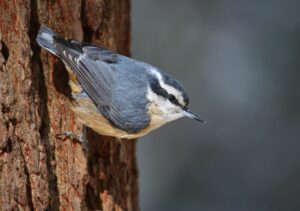
How can you tell the difference between a male and female nuthatch?
Distinguishing male and female nuthatches can be tricky, as the differences are usually subtle. However, with careful observation, you can often tell them apart based on certain features:
Coloration:
- White-breasted Nuthatch: In this species, males have a blacker cap and slightly brighter rusty flanks compared to females, whose caps are more grayish-brown and have duller flanks.
- Red-breasted Nuthatch: Males have a darker, more extensive black mask extending around the eye, while females have a browner head with a less defined mask.
- Pygmy Nuthatch: This species exhibits the least dimorphism. However, males might have a slightly blacker crown and a more extensive black streak down the breast compared to females.
- Brown-headed Nuthatch: Similar to the pygmy nuthatch, the differences are subtle. Males might have a blacker head and a broader black stripe down the breast.
Related Articles
Attracting Red-breasted Nuthatches to your backyard
Where do Red-breasted Nuthatches like to nest?
7 Kinds of Bird Feeders and the Birds That Like Them
Setting Up Your First Bird Feeder
Questions about suet? Feeding Birds Suet
25 Reasons Birds Aren’t Coming to Your Feeder



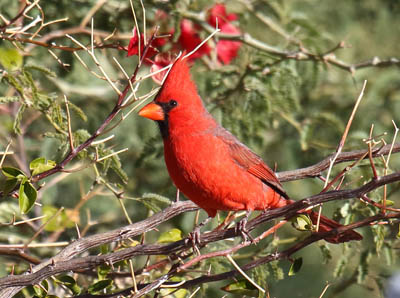
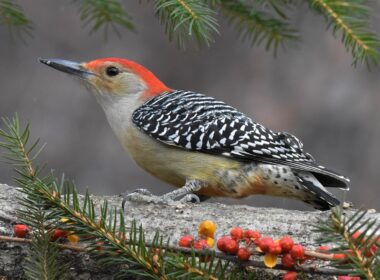
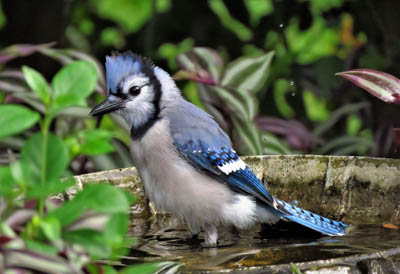
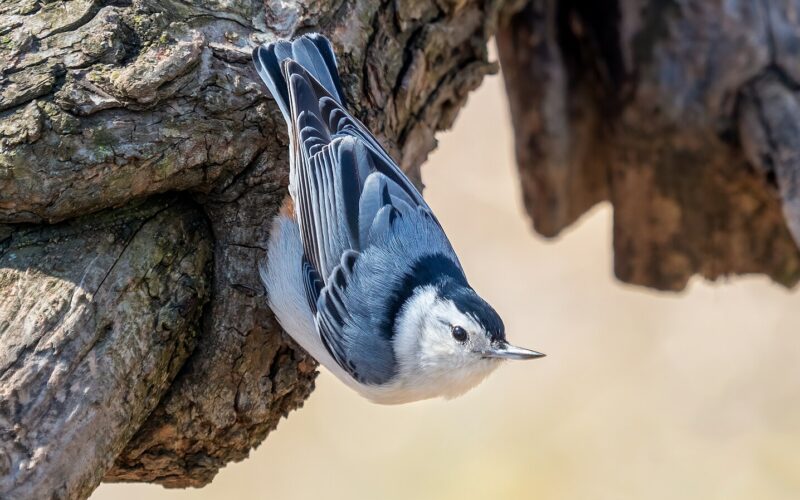
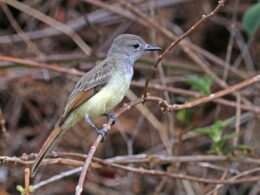
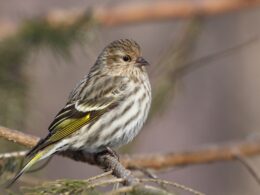
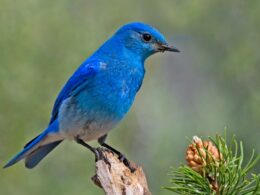
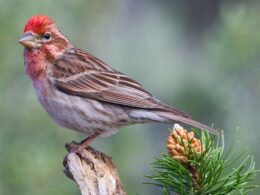
I love watching the Nuthatches here in Sweden. I'm not from here, but rather San diego, California. Moved here in 2006. I actually wrote about Nuthatches and their nesting choices, many of which I observed in little holes or slits in dry stone walls. I also stumbled upon a site which provided really kool plans for building a Nuthatch nesting hole within a brick wall and the easy ability to remove and clean it periodically.
Nuthatches and Brick Porthole Habitats